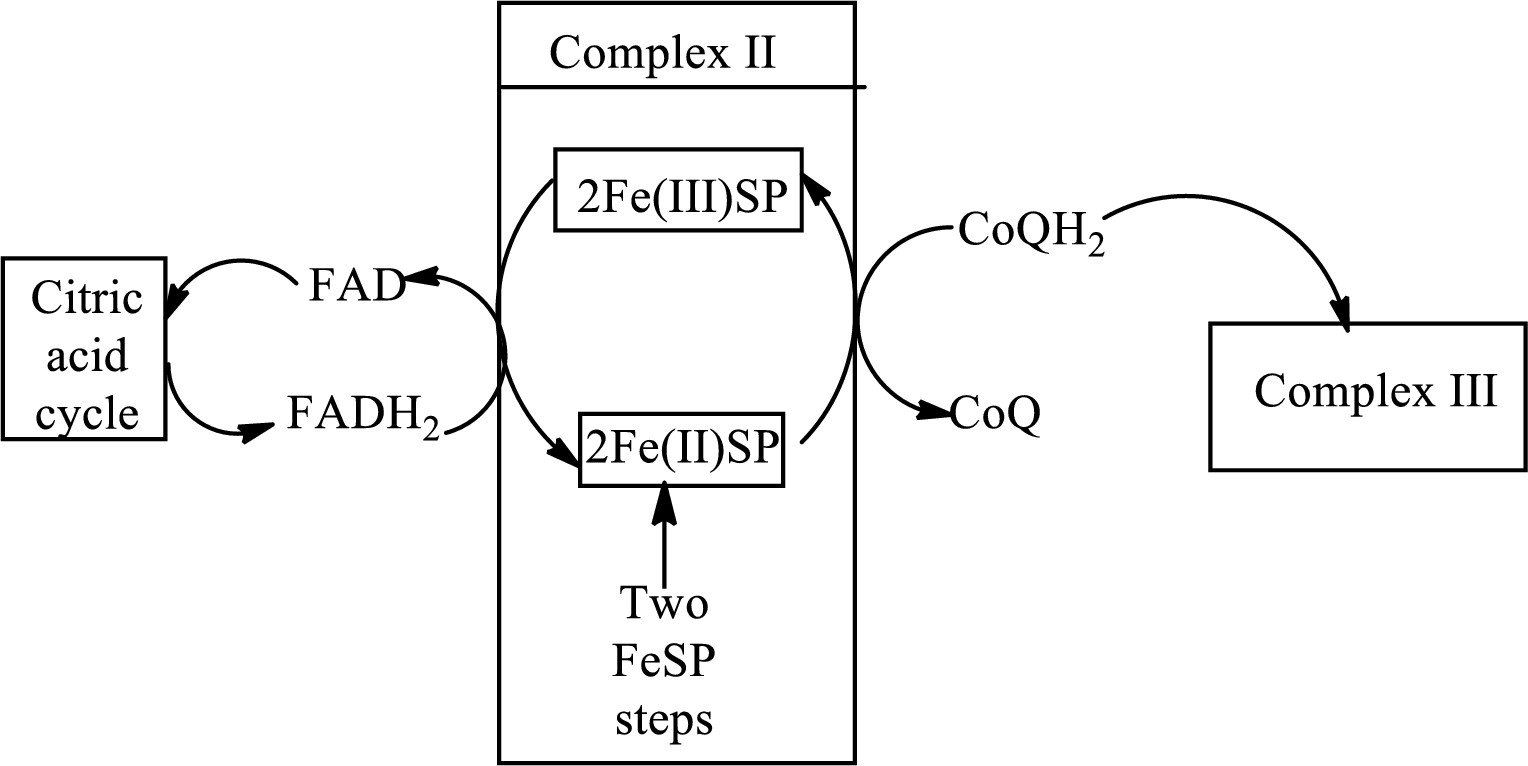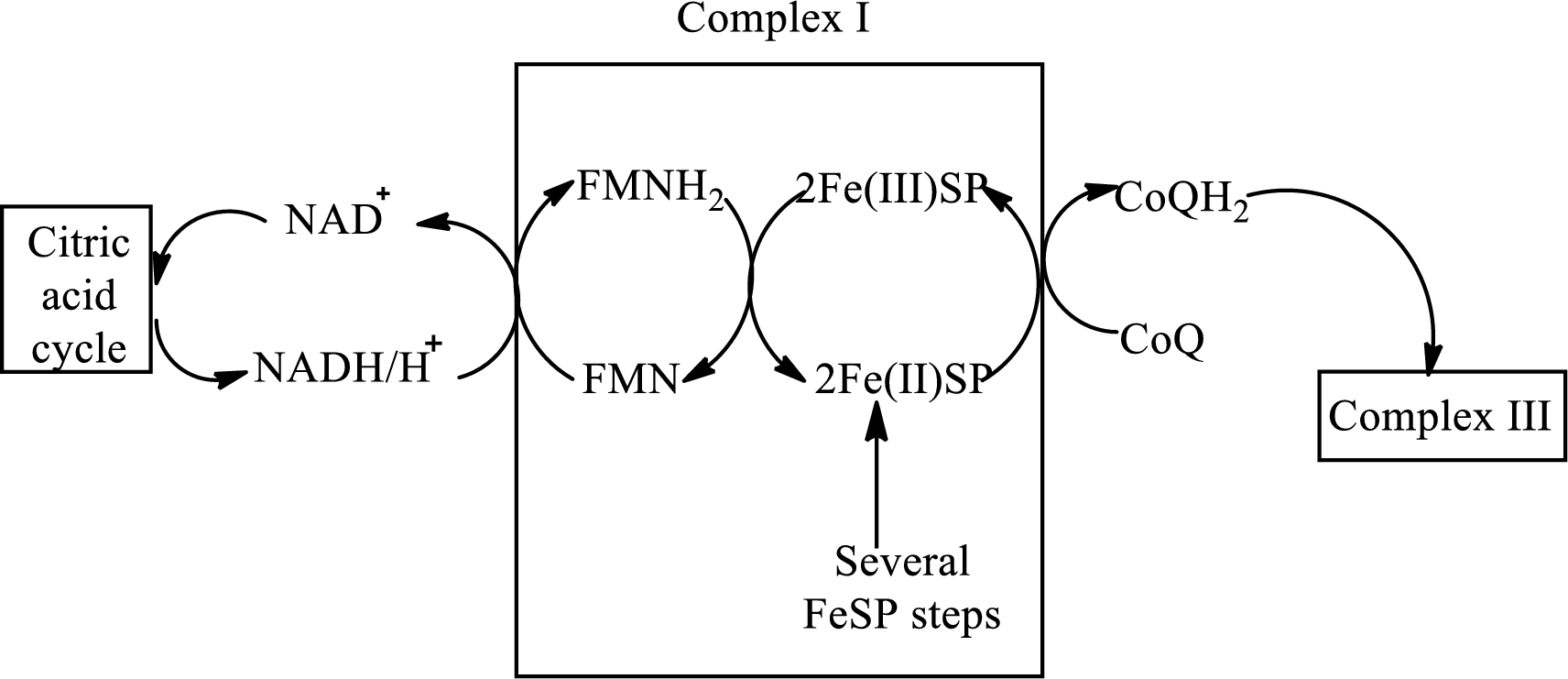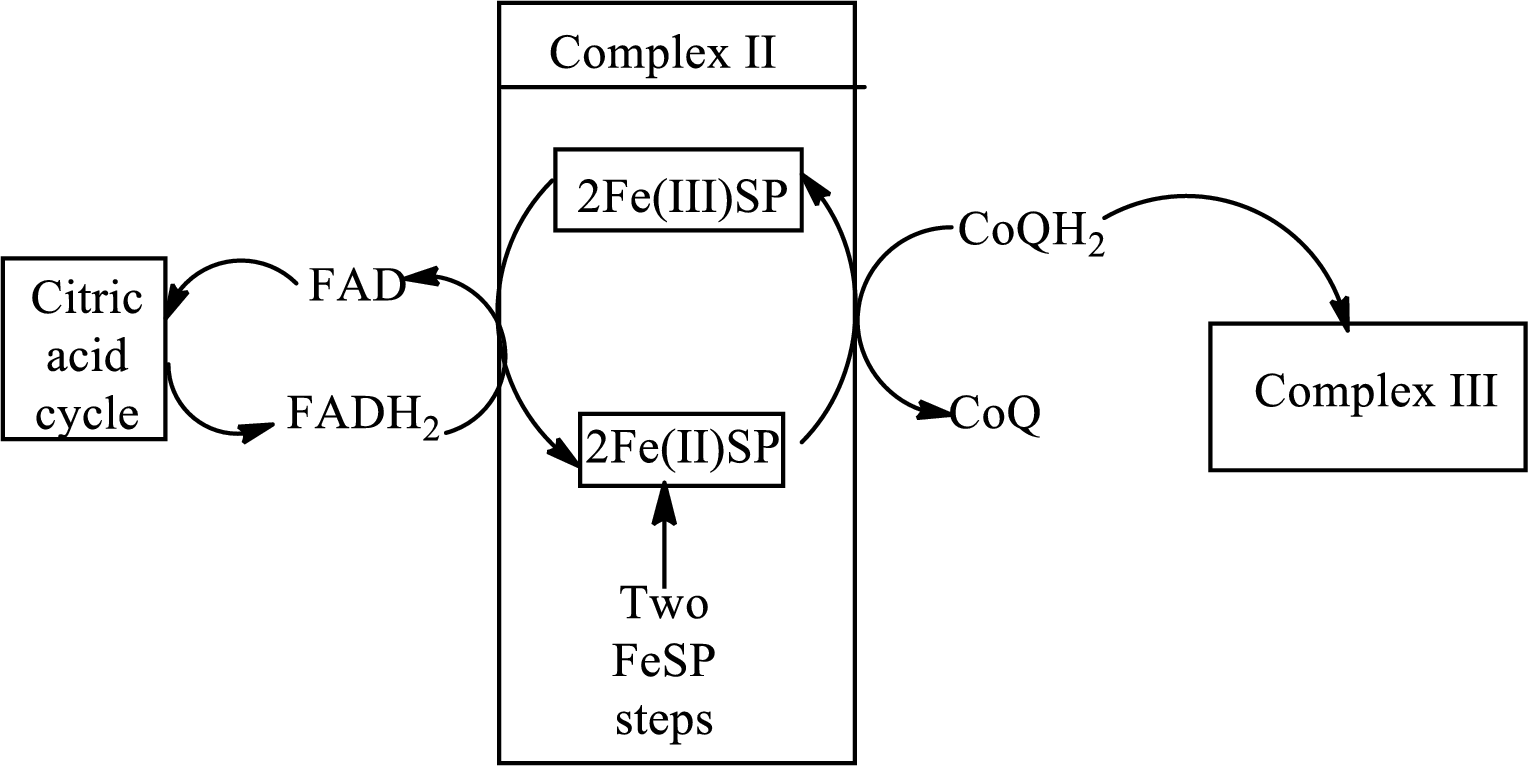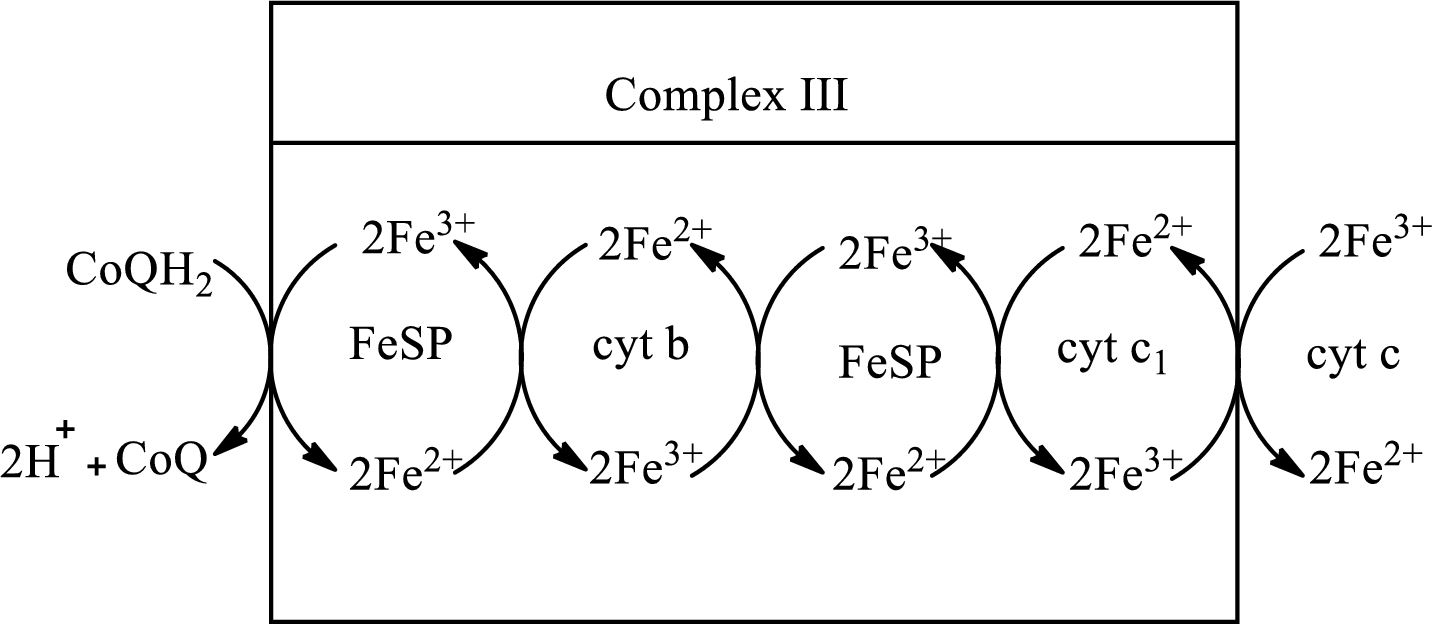
Concept explainers
(a)
Interpretation: To indicate whether oxaloacetate undergoes (1) oxidation but not reduction, (2) reduction but not oxidation, (3) both oxidation and reduction or (4) neither oxidation nor reduction in the common
Concept introduction: Common metabolic pathway is the total sum of metabolic reactions that occur in stage third and fourth of the biochemical process or it is defined as the total sum of reactions that occur in the citric acid cycle and electron transport chain and oxidative phosphorylation.
These stages are included in the common metabolic pathway because the reactions in these stages are the same for different kinds of food.
The citric acid cycle is the third stage of the biochemical energy production process. The cycle includes the reactions in which the acetyl part of acetyl CoA is oxidized and leads to the formation of carbon dioxide and
Electron transport chain is a sequence of biochemical reactions in which electrons and hydrogen atoms from the citric acid cycle are transferred to various intermediate carriers and finally reacts with molecular oxygen to form a water molecule.
(a)
Answer to Problem 23.103EP
Oxaloacetate undergoes neither oxidation nor reduction in the common metabolic pathway.
Explanation of Solution
Oxaloacetate undergoes condensation reaction in the first step of the citric acid cycle.
The first step involves the condensation reaction of oxaloacetate and

(b)
Interpretation: To indicate whether
Concept introduction: Common metabolic pathway is the total sum of metabolic reactions that occur in stage third and fourth of the biochemical process or it is defined as the total sum of reactions that occur in the citric acid cycle and electron transport chain and oxidative phosphorylation.
These stages are included in the common metabolic pathway because the reactions in these stages are the same for different kinds of food.
The citric acid cycle is the third stage of the biochemical energy production process. The cycle includes the reactions in which the acetyl part of acetyl CoA is oxidized and leads to the formation of carbon dioxide and
Electron transport chain is a sequence of biochemical reactions in which electrons and hydrogen atoms from the citric acid cycle are transferred to various intermediate carriers and finally reacts with molecular oxygen to form a water molecule.
(b)
Answer to Problem 23.103EP
Explanation of Solution
Nicotinamide adenine dinucleotide exists in two forms: oxidized form
The reaction of step 3 is:

The reaction of step 4 is:

The reaction of step 8 is:

(c)
Interpretation: To indicate whether FADH2 undergoes (1) oxidation but not reduction, (2) reduction but not oxidation, (3) both oxidation and reduction, or (4) neither oxidation nor reduction in the common metabolic pathway.
Concept introduction: Common metabolic pathway is the total sum of metabolic reactions that occur in stage third and fourth of the biochemical process or it is defined as the total sum of reactions that occur in the citric acid cycle and electron transport chain and oxidative phosphorylation.
These stages are included in the common metabolic pathway because the reactions in these stages are the same for different kinds of food.
The citric acid cycle is the third stage of the biochemical energy production process. The cycle includes the reactions in which the acetyl part of acetyl CoA is oxidized and leads to the formation of carbon dioxide and
Electron transport chain is a sequence of biochemical reactions in which electrons and hydrogen atoms from the citric acid cycle are transferred to various intermediate carriers and finally reacts with molecular oxygen to form a water molecule.
(c)
Answer to Problem 23.103EP
FADH2 undergoes oxidation in the common metabolic pathway.
Explanation of Solution
FADH2is the reduced form of flavin adenine dinucleotide. The main function of flavin adenine dinucleotide is to act as an oxidizing agent and used by the cell in oxidation reactions like oxidation of fatty acid. The reaction of the oxidation of FADH2 is:
FADH2undergoes oxidation in complex II of the electron transport chain.
Complex II consists of four subunits in its structure. This complex interacts initially with the electrons that are coming after the reduction of FADH2. FADH2 is oxidized to form FAD in this reaction. The diagrammatic representation of electron transfer in complex II in the electron transfer chain is:

(d)
Interpretation: To indicate whether
Concept introduction: Common metabolic pathway is the total sum of metabolic reactions that occur in stage third and fourth of the biochemical process or it is defined as the total sum of reactions that occur in the citric acid cycle and electron transport chain and oxidative phosphorylation.
These stages are included in the common metabolic pathway because the reactions in these stages are the same for different kinds of food.
The citric acid cycle is the third stage of the biochemical energy production process. The cycle includes the reactions in which the acetyl part of acetyl CoA is oxidized and leads to the formation of carbon dioxide and
Electron transport chain is a sequence of biochemical reactions in which electrons and hydrogen atoms from the citric acid cycle are transferred to various intermediate carriers and finally reacts with molecular oxygen to form a water molecule.
(d)
Answer to Problem 23.103EP
Explanation of Solution
Complex I consists of more than 40 structural subunits. Its structure has B-vitamin-containing flavin mononucleotide
The diagrammatic representation of electron transfer in complex I in the electron transfer chain is as follows:

Complex II consists of four subunits in its structure. This complex interacts initially with the electrons that are coming after the reduction of FADH2. FADH2 produced in the citric acid cycle transfers the electron to the complex II. The diagrammatic representation of electron transfer in complex II in the electron transfer chain is:

Complex III consists of 11 structural subunits. Its structural subunits contain iron-sulfur proteins and various cytochromes.

Want to see more full solutions like this?
Chapter 23 Solutions
General, Organic, and Biological Chemistry Seventh Edition
- For each reaction below, decide if the first stable organic product that forms in solution will create a new CC bond, and check the appropriate box. Next, for each reaction to which you answered "Yes" to in the table, draw this product in the drawing area below. Note for advanced students: for this problem, don't worry if you think this product will continue to react under the current conditions - just focus on the first stable product you expect to form in solution. དྲ。 ✗MgBr ? O CI Will the first product that forms in this reaction create a new C-C bond? Yes No • ? Will the first product that forms in this reaction create a new CC bond? Yes No × : ☐ Xarrow_forwardPredict the major products of this organic reaction: OH NaBH4 H ? CH3OH Note: be sure you use dash and wedge bonds when necessary, for example to distinguish between major products with different stereochemistry. Click and drag to start drawing a structure. ☐ : Sarrow_forwardPredict the major products of this organic reaction: 1. LIAIHA 2. H₂O ? Note: be sure you use dash and wedge bonds when necessary, for example to distinguish between major products with different stereochemistry. Click and drag to start drawing a structure. X : ☐arrow_forward
- For each reaction below, decide if the first stable organic product that forms in solution will create a new C - C bond, and check the appropriate box. Next, for each reaction to which you answered "Yes" to in the table, draw this product in the drawing area below. Note for advanced students: for this problem, don't worry if you think this product will continue to react under the current conditions - just focus on the first stable product you expect to form in solution. NH2 tu ? ? OH Will the first product that forms in this reaction create a new CC bond? Yes No Will the first product that forms in this reaction create a new CC bond? Yes No C $ ©arrow_forwardAs the lead product manager at OrganometALEKS Industries, you are trying to decide if the following reaction will make a molecule with a new C-C bond as its major product: 1. MgCl ? 2. H₂O* If this reaction will work, draw the major organic product or products you would expect in the drawing area below. If there's more than one major product, you can draw them in any arrangement you like. Be sure you use wedge and dash bonds if necessary, for example to distinguish between major products with different stereochemistry. If the major products of this reaction won't have a new CC bond, just check the box under the drawing area and leave it blank. Click and drag to start drawing a structure. This reaction will not make a product with a new CC bond. G marrow_forwardIncluding activity coefficients, find [Hg22+] in saturated Hg2Br2 in 0.00100 M NH4 Ksp Hg2Br2 = 5.6×10-23.arrow_forward
- give example for the following(by equation) a. Converting a water insoluble compound to a soluble one. b. Diazotization reaction form diazonium salt c. coupling reaction of a diazonium salt d. indacator properties of MO e. Diazotization ( diazonium salt of bromobenzene)arrow_forward2-Propanone and ethyllithium are mixed and subsequently acid hydrolyzed. Draw and name the structures of the products.arrow_forward(Methanesulfinyl)methane is reacted with NaH, and then with acetophenone. Draw and name the structures of the products.arrow_forward
- 3-Oxo-butanenitrile and (E)-2-butenal are mixed with sodium ethoxide in ethanol. Draw and name the structures of the products.arrow_forwardWhat is the reason of the following(use equations if possible) a.) In MO preperation through diazotization: Addition of sodium nitrite in acidfied solution in order to form diazonium salt b.) in MO experiment: addition of sodium hydroxide solution in the last step to isolate the product MO. What is the color of MO at low pH c.) In MO experiment: addition of sodium hydroxide solution in the last step to isolate the product MO. What is the color of MO at pH 4.5 d.) Avoiding not cooling down the reaction mixture when preparing the diazonium salt e.) Cbvcarrow_forwardA 0.552-g sample of an unknown acid was dissolved in water to a total volume of 20.0 mL. This sample was titrated with 0.1103 M KOH. The equivalence point occurred at 29.42 mL base added. The pH of the solution at 10.0 mL base added was 3.72. Determine the molar mass of the acid. Determine the Ka of the acid.arrow_forward
 Chemistry In FocusChemistryISBN:9781305084476Author:Tro, Nivaldo J., Neu, Don.Publisher:Cengage Learning
Chemistry In FocusChemistryISBN:9781305084476Author:Tro, Nivaldo J., Neu, Don.Publisher:Cengage Learning Chemistry for Today: General, Organic, and Bioche...ChemistryISBN:9781305960060Author:Spencer L. Seager, Michael R. Slabaugh, Maren S. HansenPublisher:Cengage Learning
Chemistry for Today: General, Organic, and Bioche...ChemistryISBN:9781305960060Author:Spencer L. Seager, Michael R. Slabaugh, Maren S. HansenPublisher:Cengage Learning General, Organic, and Biological ChemistryChemistryISBN:9781285853918Author:H. Stephen StokerPublisher:Cengage Learning
General, Organic, and Biological ChemistryChemistryISBN:9781285853918Author:H. Stephen StokerPublisher:Cengage Learning Organic And Biological ChemistryChemistryISBN:9781305081079Author:STOKER, H. Stephen (howard Stephen)Publisher:Cengage Learning,
Organic And Biological ChemistryChemistryISBN:9781305081079Author:STOKER, H. Stephen (howard Stephen)Publisher:Cengage Learning, Introduction to General, Organic and BiochemistryChemistryISBN:9781285869759Author:Frederick A. Bettelheim, William H. Brown, Mary K. Campbell, Shawn O. Farrell, Omar TorresPublisher:Cengage LearningChemistry: Matter and ChangeChemistryISBN:9780078746376Author:Dinah Zike, Laurel Dingrando, Nicholas Hainen, Cheryl WistromPublisher:Glencoe/McGraw-Hill School Pub Co
Introduction to General, Organic and BiochemistryChemistryISBN:9781285869759Author:Frederick A. Bettelheim, William H. Brown, Mary K. Campbell, Shawn O. Farrell, Omar TorresPublisher:Cengage LearningChemistry: Matter and ChangeChemistryISBN:9780078746376Author:Dinah Zike, Laurel Dingrando, Nicholas Hainen, Cheryl WistromPublisher:Glencoe/McGraw-Hill School Pub Co





